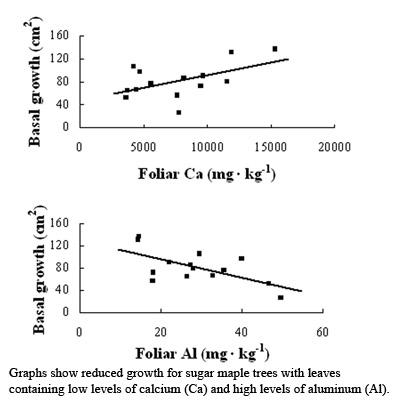Testing for Biological Calcium Depletion at the Forest and Landscape Levels

Scientists have reported sugar maple decline throughout the northeastern United States and Quebec during the past 50 years. Insect defoliation, drought, and freezing have been implicated as stress factors, and recent studies point to soil and foliar calcium deficiency as potential instigators in sugar maple decline. Calcium is a critical nutrient that helps plant cells sense and respond to stress. Uptake of soil calcium by tree roots is inhibited by high levels of soil aluminum released when acid precipitation disrupts the natural breakdown of rock and soil.
To assess the role of site nutrition in sugar maple decline, NSRC researchers evaluated soil and foliar nutrients and tree diameter growth and crown health of sugar maple trees in 14 forest stands in Vermont. The stands represented a range in calcium availability based on bedrock geology. Of all the nutrients tested, only calcium and aluminum appeared to be directly linked to tree growth and health. Healthier stands had higher levels of soil calcium. Trees with more branch dieback had low foliar calcium and high foliar aluminum. Average annual tree growth during the decade prior to testing was lower for trees in stands with low foliar calcium and high foliar aluminum.
Although the 14 stands differed widely in average tree age, site history, and site characteristics such as elevation and drainage, relationships of foliar calcium and aluminum to stand growth and health were consistent. The results emphasize the importance of calcium and aluminum to sugar maple health and highlight the vulnerability of sugar maple stands to declines following continued loss of calcium from the Northern Forest.
